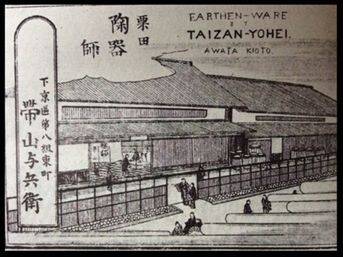10. Taizan Yohei
TAIZAN Taizan Yohei IX (1856-1922)
帯山 陽平
Takahashi Yohei, artist name Taizan, was the head of the 9th and final generation of the Takahashi family of Awata potters. The family specialized in tea utensils, blue glazed pottery, porcelains with celadon glazes and pottery with overglaze enamels. The First generation in this line of potter was Takahashi Tokuro, working in the second part of the 17th and beginning of the 18th century till 1711, producing raki ware. It was the second generation who adopted the go name ‘Taizan’, so the 9th generation of this family is actually is the 8th Taizan Yohei. Since he is better known as Yohei IX, we will use this.

According to Gisela Jahn (Meiji CeramisTakahashi Yohei was a younger brother of Kiyomizu Rokubei IV, who was adopted in the Taizan family of potters after the death of Taizan Yohei VII in 1875, and changing his name in Taizan in 1878. He transformed the family pottery in Kyoto to a large factory making Satsuma wares, exporting their products together with Kinkozan VI, in particular to America where his products were much sought after.
The Taizan kiln appears to have closed around 1894. However in 1895 and 1901 reports have it that Taizan is still working “on a comparatively small scale”. The production seems to have been maintained until Taizan Yohei IX died in 1922. During the end of the Meiji period and into Taisho, Taizan decorated blanks from Kinkozan, Izumo Wakayama, etc.
Pieces occur that have both Kinkozan and Taizan markings where generally the Kinkozan mark is impressed in the piece itself and the Taizan mark is written. The firing of enamel decoration is an uncomplicated process compared to firing ceramics and could have been done anywhere. According to this information it is assumable to say that pieces with an impressed Taizan mark is always dating before 1894, while pieces without impressed mark of another kilns mark are dating from the late Meiji or early Taisho period.
Taizan Yohei IX was a renowned potter who exhibited and won prizes at a number of international events, including the 1893 Chicago World Expo. He often based his work on drawings by Kono Bairei, famous for drawing and illustrating birds and flowers in the Kacho style.

It must be emphasized that in Meiji period more Taizans were active, not being Taizan Yohei. The Taizan Yohei signature is clear and easy to recognize.


A 31 cm charger by Taizan Yohei, with painted signature and impressed mark.

Lidded pot with flower and butterfly design, overglazed with gold, from the Yokoyama Art Museum

pair of vases depicting flowers andbutterflies and detail, showing the high quality of Taizan Yohei's decoration skills.


Maak jouw eigen website met JouwWeb